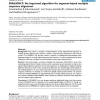342 search results - page 19 / 69 » A New Alignment-Independent Algorithm for Clustering Protein... |
BMCBI
2005
13 years 7 months ago
2005
Background: We present a complete re-implementation of the segment-based approach to multiple protein alignment that contains a number of improvements compared to the previous ver...
BMCBI
2007
13 years 7 months ago
2007
Background: Protein aggregation correlates with the development of several debilitating human disorders of growing incidence, such as Alzheimer's and Parkinson's disease...
EVOW
2010
Springer
13 years 10 months ago
2010
Springer
A challenging problem in bioinformatics is the detection of residues that account for protein function specificity, not only in order to gain deeper insight in the nature of functi...
VLDB
2002
ACM
14 years 7 months ago
2002
ACM
Our aim is to develop new database technologies for the approximate matching of unstructured string data using indexes. We explore the potential of the suffix tree data structure i...
BMCBI
2004
13 years 7 months ago
2004
Background: The prediction of ancestral protein sequences from multiple sequence alignments is useful for many bioinformatics analyses. Predicting ancestral sequences is not a sim...

